E-tractors could radically change the agricultural landscape by scaling sustainability and increasing efficiency.
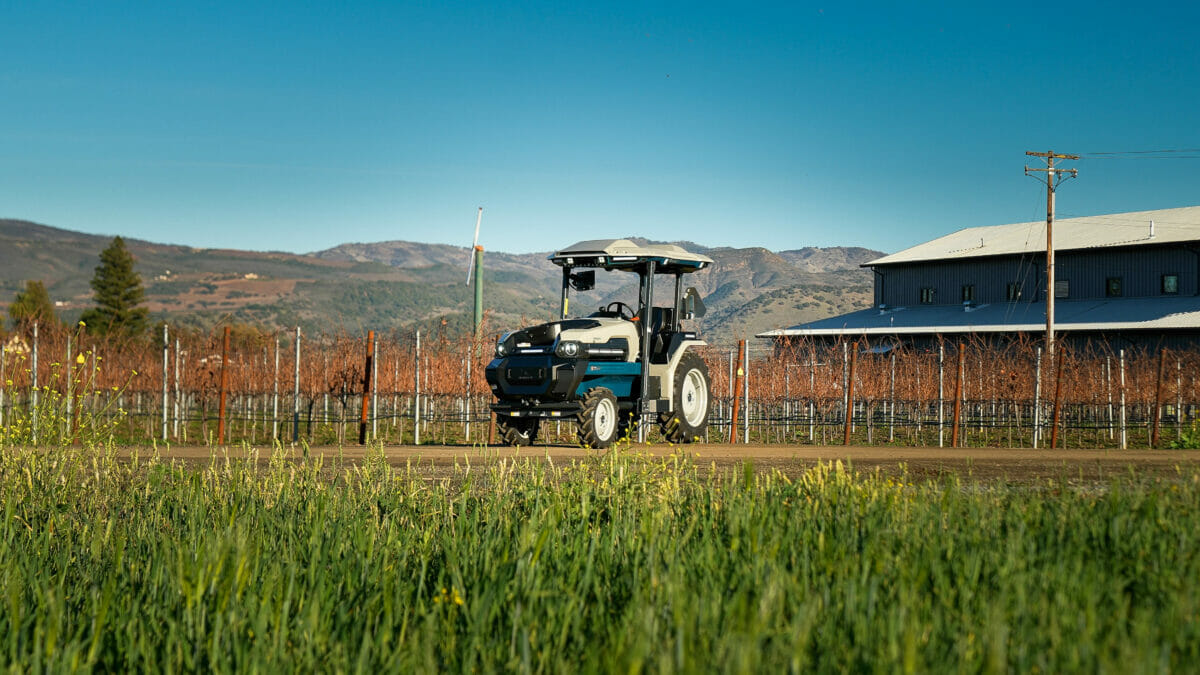
A quiet revolution is rolling across American farms—and it’s so hushed that you may have to strain your ears to hear it.
Although diesel tractors are practically synonymous with farming, green technology is reshaping the relationship between farmers and these workhorses—and perhaps the nature of agriculture altogether.
An emerging fleet of whisper-silent and emissions-free tractors promises to unhitch growers from the burdens of conventional farming, far beyond its reliance on fossil fuels. By harnessing electric vehicle (EV) and robotics technology, driver-optional e-tractors help scale efficiency in all aspects of field work—from seeding and weeding to harvest and equipment repair—and may clear the path to better labor, field and sustainability practices.
“People don’t build that much in factories anymore. Machines do, and people are there to supervise them,” says Mark Schwager, co-founder and president of San Francisco Bay Area-based Monarch Tractor, which recently debuted the first-ever, autonomous e-tractor. “That’s how farming should be.”
Electric tractors have their roots in Northern California, an agriculture- and tech-heavy region. Sonoma County-based Solectrac launched the first model in 2017 and, despite a slow start—the company sold about two dozen vehicles in its first four years—sales finally gained traction last year, helped by state grants and increased manufacturing capacity.
The development of e-tractors trails the EV industry, says Schwager, which commoditized the production of lithium-ion batteries, motors and power components. Monarch was founded in 2018, miles from Tesla’s Fremont factory, allowing it to tap into the established manufacturing base.
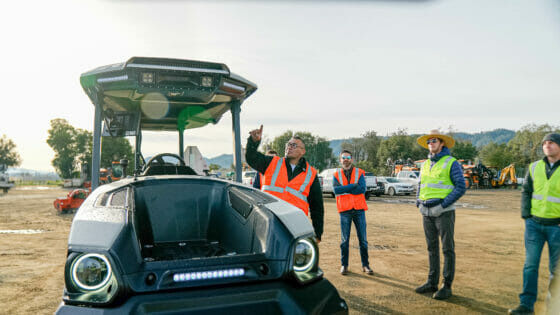
Monarch’s Mark-V model incorporates autonomous EV technology. (Photo courtesy of Monarch Tractor)
Zero emissions is a key selling point of any plug-in vehicle. But with a diesel tractor spewing carbon and particulate volumes equal to that of 14 cars, replacing one with an electric version can have remarkably scaled impact, says Schwager, with no change in productivity.
The auto-sized battery can last up to 14 hours on a single 5.5-hour charge (Schwager notes that barns are generally equipped with 220-volt plugs), and it has a lifespan of 15 to 25 years depending on frequency of use. An optional cart for toting a spare battery allows for quick, in-field swaps during power-intensive operations.
Eliminating emissions is only part of the package. Equipped with sensory cameras and a fully digital interface, Monarch’s debut model, the compact Mark-V, incorporates autonomous EV technology: The driver-optional tractor can be programmed for automated runs, guided remotely through fields and orchards to spray, disk or harrow or follow workers as they move along a row of crops, carrying supplies or hauling a harvest.
In an industry plagued with labor shortages and a rapidly aging workforce, “it’s going to fill jobs that can’t be filled,” says Schwager. Using the autonomous capabilities, for example, one person can control a fleet of tractors from a screen to oversee multiple tasks spread throughout a farm.
Automation could also help relieve workers from laboring in inclement conditions, he adds, and encourage growers to adopt greener practices. “If mowing runs aren’t costing you anything, weeds need much less spraying.”
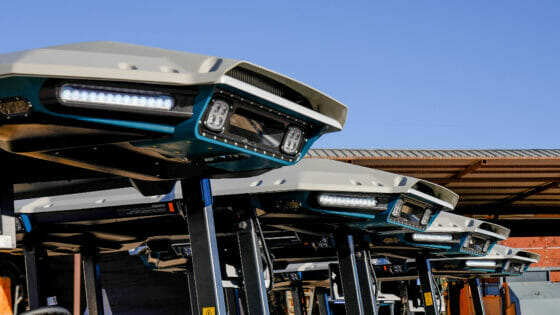
Photo courtesy of Monarch Tractor.
Domenick Buck, director of coastal services at Coastal Vineyard Care Associates in Santa Barbara, recently added 18 of the e-tractors to his vineyard management company’s fleet of 40 diesel engines. Although he’s found the EV’s weight capacity limited in towing wider and heavier implements, the fuel savings and automated features—including night vision capabilities that allow fieldwork to continue past sunset—all help the bottom line, he says. And while the technology has induced worker concerns over job security, “at this point, it’s not a replacement,” he adds. “By allocating certain tasks, it supplements what we already have,” helping to ease anxiety over the scarcity and rising cost of labor.
As an organic and biodynamic operation, “we’re also mindful of our lasting [impacts] on a property,” says Buck, “so we’re excited about reducing our carbon footprint.” And the reduced noise pollution is a bonus, he adds—instead of the roar and rumble of a diesel engine, “this thing just hums along.”
With a base price of $89,000—more than double that of a conventional compact—the savings can come at a cost. Schwager notes, however, that California offers generous rebates that can drop the price down to or lower than that of a diesel tractor. Monarch is working with other states and the federal government on similar programs, although the timeline is still unclear.
Yet the switch to electric can still work for those on a budget. With a base price of $12,990, the Amiga, a robotic micro-tractor, offers small growers a big labor solution, one that can be scaled and tailored to accommodate a wide range of needs.
Developed by farm-ng, a robotics technology company based in Watsonville, just south of Silicon Valley, the Amiga looks more moon rover than clover weeder as it zips along the rural landscape. The four-wheel platform comes with a telescoping dashboard, and it runs on swappable e-bike batteries that last up to eight hours per charge. Despite the size, the one-horsepower drivetrain can tow or haul a thousand-pound payload, and it also sports a host of autonomous and remote functions.
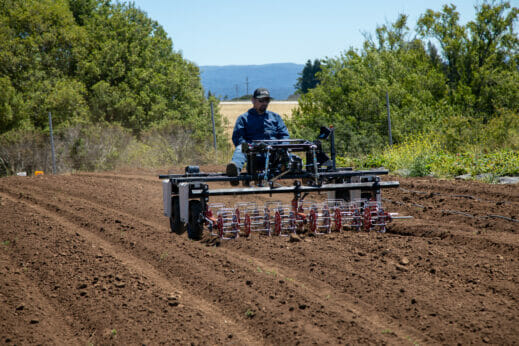
The Amiga with a basket weeder and driver’s seat attachments. (Photo courtesy of farm-ng)
“We’re reluctant to call it a tractor, because we’re not trying to replace them,” says business development director Nathan Dorn. “We’re replacing work that’s more precise and more difficult,” and even venturing into new territory such as greenhouses and barns.
Expandable in width from 3 to 7.5 feet, the Amiga is designed for modularity. The weldable steel frame allows multiple configurations and user customization, and it accommodates add-ons such as a precision seeder, a three-point powerlifter and even a driver’s seat. “It’s a building block for farmers,” says Dorn.
Autonomous functions include self-guided and remote navigation—farm-ng is also developing a similar technology for guiding the Blue Ghost Lunar Lander to a precise location on the moon’s surface—as well as “follow me” capabilities.
Combined with Amiga’s open-source platform, it’s a blank canvas for endless hacks, says Dorn. The camera can be used to inventory trees in an orchard or cows on a pasture, for example, or use visual clues to gauge crop ripeness. He envisions users developing, sharing and even monetizing creative software via the company’s online app store, much like a smartphone.
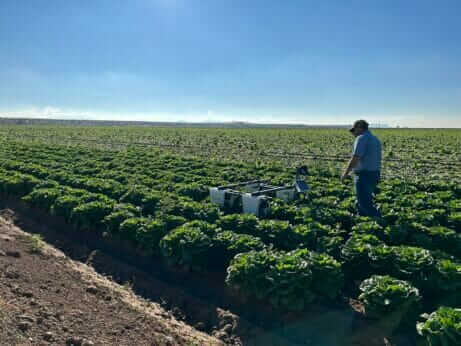
Jason Mellow from Axis Ag uses visual data capture on a lettuce crop in Yuma, Arizona. (Photo courtesy of farm-ng)
Despite initial skepticism from his crew around the robotic addition, “I think we pretty much have total buy-in at this point,” says Ricardo Lopez, vegetable production manager of Rancho Soquel. Located in Santa Cruz County, the 17-acre organic and regenerative ranch grows a diverse range of crops—as much as 40 varieties in a given season—including tomatoes, salad greens and snap peas.
The farm, which includes grazing pastures and an orchard, has relied on mini-tractor-like, rough terrain vehicles (RTV) to transport supplies. But RTVs weigh heavily on the fields so they’re kept to the perimeters, requiring workers to carry tools, equipment and harvests by hand.
The compact and lightweight Amiga, on the other hand, treads lightly and “gives us flexibility around specific needs like sowing and in-bed cultivation,” says Lopez. “And people are excited about not having to haul around crates anymore.”
California rebates also apply to the Amiga, notes Dorn, and can reduce the cost by as much as 90 percent. Yet switching from a diesel tractor alone carries inherent savings: A full electric charge is cheaper than a tank of gas, and not having an engine eliminates maintenance costs such as particulate filter replacements, which, according to Schwager, can run nearly $3,000. (All tractors, however, require hydraulic maintenance.)
Both Monarch and farm-ng openly support the right to repair—a seemingly rare position in the industry—and offer free, over-the-air support and updates to software and operating systems. Remote monitoring also alerts owners to issues and service needs, which, along with walk-through support, makes the technology less daunting, more accessible and more affordable.
“I’ve had robots in factories for my entire career and think it’s unfair that farmers haven’t had the same thing,” says Schwager. “So I see great potential for technology to bring farming into the twenty-first century.”
I appreciate this article, and found it very interesting. But I have some grave concerns about e-tractors (e-vehicles in general) after this past winter. Living on a farm in the Bay Area, we experienced 7 power outages between Dec. 30 and April 1; 15 days total without power. If we anticipate more severe storms in future winters (or hot summers, where PG&E does preventative black outs to prevent fires) – and you have an e-vehicle – how is it supposed to be charged? How will work get done? What will happen in an emergency, if you have to get out?… Read more »
What is a more realistic number for how long the tractor will last under load? The Ford F150 Lightning has great run-time when it is empty, but as soon as you haul anything of significance, you lose about half of the range.
zero emission if youre not counting the resources to make a battery of that capacity. for farming id imagine a hybrid concept would be a lot more reasonable and feasible.